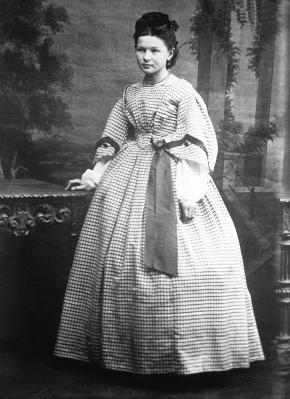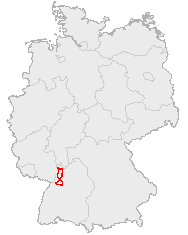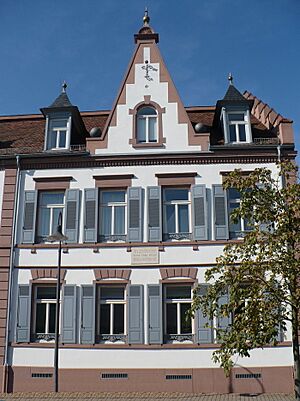Bertha Benz facts for kids
Quick facts for kids
Bertha Benz
|
|
|---|---|
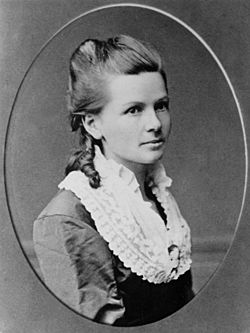
Bertha Ringer, circa 1871, as she became Karl Benz's business partner
|
|
| Born |
Cäcilie Bertha Ringer
3 May 1849 |
| Died | 5 May 1944 (aged 95) Ladenburg, Germany
|
| Nationality | German |
| Known for | First person in history to drive an automobile over a long distance |
| Spouse(s) | Karl Benz (m. 20 July 1872 – 4 April 1929, his death) |
| Children | 5 |
| Relatives | Johann Benz (father-in-law) Josephine Benz (mother-in-law) |
Bertha Benz (born Cäcilie Bertha Ringer; May 3, 1849 – May 5, 1944) was a brave German inventor and a very important person in the history of cars. She was the wife and business partner of Karl Benz, who invented the first car.
On August 5, 1888, she became the first person to drive a car a long distance. She drove the "Patent Motorwagen" for about 65 miles (105 km). During her trip, she even invented new things like brake pads! Her amazing journey helped the Benz car become famous around the world and led to the first car sales.
Contents
Bertha's Early Life and Marriage
Bertha Ringer was born on May 3, 1849, in Pforzheim, Germany. Her family was quite wealthy.
Before she married Karl Benz, Bertha used some of her own money to invest in his struggling company. At that time, unmarried women could make their own investments. However, after she married Karl on July 20, 1872, the law changed. Bertha lost her legal power to act as an investor.
Even so, she continued to support Karl financially. She used her money to help him start his new car-making business, Benz & Cie.
Karl finished building his first car in December 1885. Bertha was like a test driver for him. She helped improve the car's design, adding wire insulation and inventing leather brake pads. She also noticed other things that Karl later made better, like the fuel line. Bertha was key in helping to pay for the car's development. If it were today, she would have shared the patent rights. But back then, married women were not allowed to be named as inventors.
Bertha and Karl had five children together: Eugen, Richard, Clara, Thilde, and Ellen.
The First Motor Car
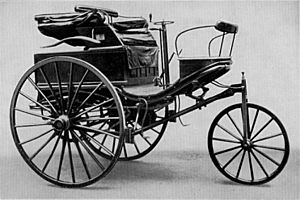
In 1886, Karl Benz showed the world his amazing invention: the Patent-Motorwagen. This was the world's first true automobile! Over the next ten years, about 25 of these cars were built.
The first model, the Model I, was the original Patent Motor Car. It was built with advanced bicycle parts.
The Model II was changed into a four-wheeled car for testing. It was the only one of its kind.
The Model III was the first Patent Motor Car sold to customers. It had powered rear wheels with solid rubber tires and a steerable front wheel. Customers could choose different seating and even a folding roof.
Bertha's Historic Road Trip
On August 5, 1888, Bertha Benz, who was 39 years old, did something amazing. Without telling her husband or getting permission from the authorities, she drove a Model III car from Mannheim to Pforzheim. Her sons, Richard (13) and Eugen (15), went with her. This made her the first person to drive a car a long distance! Before this, car trips were only very short tests, usually with mechanics helping. Bertha's trip covered about 65 miles (106 km) one way.
Bertha said she was going to visit her mother. But she had other reasons too. She wanted to show her husband that his invention could be very useful to everyone. She also wanted to give him confidence that his car had a bright future. Karl had not thought much about how to sell his invention.
She started her journey around sunrise. She faced many challenges along the way and showed how smart and skilled she was. The car only had a small fuel tank, holding about 4.5 liters of petrol. Bertha needed a special fuel called ligroin. She found it only at drugstores. So, she stopped at a pharmacy in Wiesloch to buy more fuel. This pharmacy became the world's first gas station!
Bertha had to fix things on the road. She used her hat pin to clear a blocked fuel line. She even used her garter as insulating material. At one point, a blacksmith helped her fix a chain. When the wooden brakes started to fail, Bertha visited a shoemaker. He helped her put leather on the brakes, creating the world's first brake linings!
The car's engine was cooled by water, so they had to add water often. The car only had two gears, which made going uphill very hard. Eugen and Richard often had to push the car up steep roads. Bertha reached Pforzheim after dark and sent a telegram to her husband to tell him about her successful trip. She drove back to Mannheim a few days later.
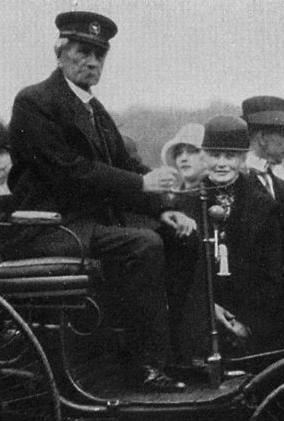
Her amazing trip got a lot of attention, just as she hoped. It was a very important moment for cars. Bertha told Karl everything that happened. She gave him great ideas, like adding another gear for hills and using brake linings to make the brakes better. Her journey proved that testing cars was super important for car companies.
Later Life and Legacy
Bertha Benz passed away in her home in Ladenburg in 1944. Karl Benz had built his workshop there after they moved in 1906. He started a family business called Benz and Sons. Karl had passed away in 1929, after his company, Daimler-Benz, became very successful. Members of the Benz family lived in the home for another 30 years.
Today, the Benz home is a historic site. It is used for scientific meetings by a non-profit group called the Gottlieb Daimler and Karl Benz Foundation. This foundation honors both Bertha and Karl Benz for their huge roles in the history of automobiles.
In 1925, Karl Benz wrote in his memories: "Only one person remained with me in the small ship of life when it seemed destined to sink. That was my wife. Bravely and resolutely she set the new sails of hope." This shows how much he valued Bertha's support.
Honors and Recognition
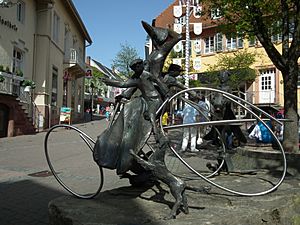
In 2008, the Bertha Benz Memorial Route became an official heritage route. It follows the exact path Bertha took on her historic journey in 1888. You can now follow the 194 km (120 miles) of signs that mark her route from Mannheim to Pforzheim and back.
The Bertha Benz Challenge was held on this route in September 2011. It was part of the "Automobile Summer 2011" event, celebrating the invention of the car. This challenge was only for cars that use new, clean energy, like hybrid, electric, hydrogen, and fuel cell vehicles. The idea was to show that cars can be both old and new, and good for the environment. The motto was Bertha Benz Challenge – Sustainable Mobility on the World's Oldest Automobile Road!.
In 2011, a TV show called Made in Germany on Deutsche Welle (DW-TV) showed a documentary about Karl Benz's invention. It highlighted the very important role his wife, Bertha Benz, played. The documentary also looked at the future of cars.
A film called The Car is Born was made by Ulli Kampelmann. It focused on Bertha Benz's first road trip.
In 2011, a TV movie about Karl and Bertha Benz's lives was made. It was called Karl & Bertha.
In 2019, for International Women's Day, the Daimler company (which owns Mercedes-Benz) made a four-minute advertisement. It showed parts of Bertha Benz's amazing 1888 journey.
See also
 In Spanish: Bertha Benz para niños
In Spanish: Bertha Benz para niños


